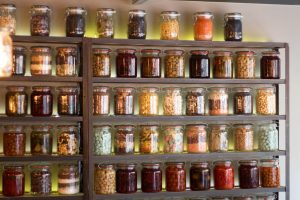Several years ago, my teammate Riley and I shared how we create our meal plans to help customers see how we use the program. I thought that post needed a refresher because I’ve refined my meal-planning process thanks to helpful tips from Plan to Eat customers!

How I meal plan.
My meal planning is simplistic. I plan for the week ahead and I only add dinner recipes to my planning calendar.
My husband and I eat the same breakfast and lunch foods every day. Breakfast could be any of the following, eggs, toast, fruit, cottage cheese, or a smoothie. I make sure we have all of those items stocked at home so we can pick and choose what sounds good. For lunch, we either eat dinner leftovers or sandwiches. For that, we keep deli meat, cheese, and canned tuna stocked.
Rather than add these ingredients to my meal planner, I simply add all these items to my weekly shopping list in bulk with the Staples List. By default, I add everything to the list first and then “shop at home” before going to the store and double-check our current quantities.
I plan 3-4 dinner recipes each week. We like to eat leftovers once or twice and go out to eat on Friday or Saturday night. Planning fewer meals for the week allows us the flexibility to not cook every night, eat out now and then, or go to a friend’s house for dinner. We like a mix of planning and spontaneity and if our dinner plans change, we aren’t overwhelmed by food in the fridge. Leftovers can be frozen and saved for a future meal or eaten for lunch as I mentioned above.
My meal plans are not set in stone because we don’t have an overly busy schedule that needs specific meals on specific days. This means the meals I add to the planner aren’t strictly for that night of the week.
I used to plan our weekly recipes on the calendar at random and then we would choose what to eat from the planned recipes. However, this method meant I was constantly double-checking my meal plan to see what recipes I had shopped for, but we hadn’t cooked yet. It worked because we liked the flexibility, but it was clunky. I was often confused about which recipes we had already made and what was left on the plan.
My weekly dinner planning now feels more intuitive, thanks to some customer comments in our Facebook group. I simply add all our weekly recipes to the first day of the week (Monday on my Planner) and drag and drop recipes onto different weekdays as we make them.


This system allows for the same flexibility I like, but makes keeping track of recipes much easier! I will add leftover notes to the planner once we make a recipe and see how many servings are left or add some to the Freezer if we decide to not eat them right away. When I go to make my shopping list, I set the date range for that one day of the week and then add all the staples and additional items we need.
How to decide what recipes to plan.
Now that I’ve given you the system, I want to dive into how I choose what recipes to add to my meal plan. Even seasoned meal planners struggle with recipe inspiration; it’s why we have hundreds of recipes in our Plan to Eat accounts!
I’m guilty of wanting a lot of variety in my meal plans. I like eating new and different flavors and learning new recipes, but sometimes I go a little overboard. When there’s too much variety in my meal plan, I spend more time cooking and often buy new spices and condiments that go to waste if I’m not intentional about using them again.
To prevent undue stress about variety, I plan at least two recipes each week that are well-known favorites. I have about a dozen of these “auto-pilot” recipes that come together quick and easy because I basically have the recipe memorized. Then for my other 1-2 recipes, I will either try something completely new or plan an older recipe I haven’t made in months.
I use the Queue to house my well-known recipes, so I don’t have to search for them. And then I will choose my “variety” recipes either from my Recently Added list or by searching for an ingredient we have at home that I want to use up.

Grocery shopping.
I mentioned above that I shop at home before going to the grocery store. This is a super important step for me because we have a small kitchen with limited storage space. I make a conscious effort to not overshop because our cupboards will end up jammed full and cluttered. So I shop at home, add our extra staples to the list, and then shop in person at the store. I like to shop for sales and clearance items, so I prefer to go to the store rather than order grocery pick-up.
I try to grocery shop only once a week, but sometimes I have to make a second quick trip for one or two staple items I miscalculated at home (this happens with half and half a lot!).
This simple, flexible style of meal planning works well for me and my husband for our current stage of life. If you’re interested in learning about other methods for meal planning, check out the How to Meal Plan blog series I put out last year! These six blog posts detail the systems other Plan to Eat customers use to create their meal plans.
P.S. You can also learn how Riley’s meal planning has changed over the years from this podcast interview.






